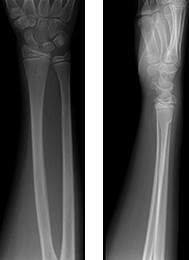Peer Reviewed
Feature Article Orthopaedics
Childhood fractures: a guide to management
Abstract
Childhood fractures are extremely common. The risk of sustaining a fracture during childhood is said to be 42% for a boy and 27% for a girl. A working knowledge of management is therefore paramount.
Key Points
- Assess the child as a whole – are there injuries other than the fracture? Could the injuries be life-threatening? Attend to: airway, breathing and circulation (ABC) plus cervical spine stabilisation first. Does the fracture itself warrant immediate attention in theatre or by a specialist?
- Children are not small adults – anatomical, physiological and biomechanical differences govern the principles of fracture management.
- A number of fractures are specific to childhood, e.g. greenstick, torus, physeal. Each fracture is individual to a patient (and the parents!).
- Do not rely solely on plain radiographs for fracture diagnosis; there is no substitute for a well taken history and an accurate clinical examination. Comparison radiographs of the uninjured side can prove extremely helpful, especially around difficult sites (such as the elbow).
- Complications secondary to childhood fractures are rare, but can have devastating long term and progressive functional and cosmetic effects for the patient when they occur.
- If you are in doubt about the best management for an individual fracture, seek the help of an orthopaedic surgeon – preferably one with a special interest in paediatric fractures.
Purchase the PDF version of this article
Already a subscriber? Login here.

